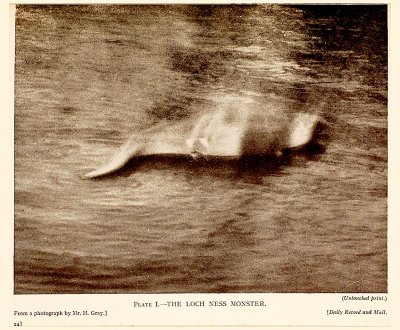Zeke Newbold
Carbon based biped.
- Joined
- Apr 18, 2015
- Messages
- 1,249
I'm chewing over a very old chestnut here - but it's an interesting experiment in perception and possible paredolia.
The Hugh Gray 1933 photo of an alleged Loch Ness Monster is thought to be the first of its kind.
The received wisdom of it has since become that it shows nothing more than a dog - a sandy coloured labrador - swimming towards the viewer with a stick in its mouth.
That has always been my take on it too - and I find that once you see the damned dog - you just can't unsee it!
The born again Nessie sceptic Tony Hamsworth has said, somewhere, that he once showed the picture to a group of primary school kids without context, and that they all immediately volunteered that it was a dog with a stick in its mouth!
Nevertheless, the venerable Glasgow Boy - surely Britain's last die hard Nessie believer - has put up a spirited and elaborate defence of the picture as showing something else entirely and the dog image as being a case of paredolia. (Strap yourself in for a long and detailed read).
http://lochnessmystery.blogspot.com/2011/06/hugh-gray-photograph-revisited_26.html
I was never won over by his cunning argument as it seemed overwrought - because it had to be.
Recently though I was able to conduct my own experiment. I showed this image to an objective party: a Russian woman who had only dimly heard of the Loch Ness Monster and certainly had no previous exposure to this image. As an English language teacher I was teaching Modals of Possibility (may be, could be,might be, etc) and used a printed copy of the picture to get her to use these this language. I didn't even tell her that the picure was taken at Loch Ness - just asked her to describe it using Modals of Possibility.
She theorised that it could be a submarine or a dolphin...but the notion of it being a stick wielding canine did not occur to her, and I'm not sure she even saw it when I pointed it out. I should add that the woman concerned is a dog lover (a proud owner of a puppy) and an artist (hence visually minded).
So..what about you? Can you see the dog? Can you unsee the dog? And what do you think the image really shows? I'm dogoned!

The Hugh Gray 1933 photo of an alleged Loch Ness Monster is thought to be the first of its kind.
The received wisdom of it has since become that it shows nothing more than a dog - a sandy coloured labrador - swimming towards the viewer with a stick in its mouth.
That has always been my take on it too - and I find that once you see the damned dog - you just can't unsee it!
The born again Nessie sceptic Tony Hamsworth has said, somewhere, that he once showed the picture to a group of primary school kids without context, and that they all immediately volunteered that it was a dog with a stick in its mouth!
Nevertheless, the venerable Glasgow Boy - surely Britain's last die hard Nessie believer - has put up a spirited and elaborate defence of the picture as showing something else entirely and the dog image as being a case of paredolia. (Strap yourself in for a long and detailed read).
http://lochnessmystery.blogspot.com/2011/06/hugh-gray-photograph-revisited_26.html
I was never won over by his cunning argument as it seemed overwrought - because it had to be.
Recently though I was able to conduct my own experiment. I showed this image to an objective party: a Russian woman who had only dimly heard of the Loch Ness Monster and certainly had no previous exposure to this image. As an English language teacher I was teaching Modals of Possibility (may be, could be,might be, etc) and used a printed copy of the picture to get her to use these this language. I didn't even tell her that the picure was taken at Loch Ness - just asked her to describe it using Modals of Possibility.
She theorised that it could be a submarine or a dolphin...but the notion of it being a stick wielding canine did not occur to her, and I'm not sure she even saw it when I pointed it out. I should add that the woman concerned is a dog lover (a proud owner of a puppy) and an artist (hence visually minded).
So..what about you? Can you see the dog? Can you unsee the dog? And what do you think the image really shows? I'm dogoned!




